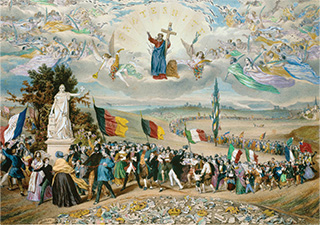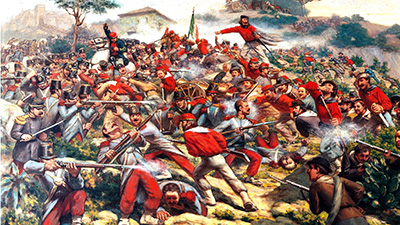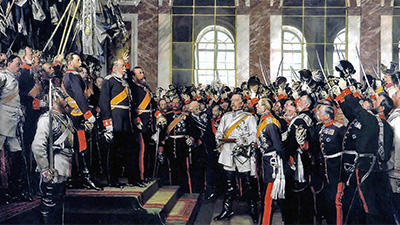Nationalism Spreads
Driving Question: What caused nationalism to spread around the world in the nineteenth century?
Discover how people around the world started to embrace nationalism for a variety of reasons, among them a growing sense of ethnic pride, a response to multiethnic regionality, and a pathway for economic and political independence.
Learning Objectives:
- Analyze the causes and consequences of world revolutions such as those in Europe, Asia, and the Middle East to understand the growth and spread of nationalism.
- Evaluate the reasons behind the successes and failures of the revolutions of 1848.
- Compare the emergence of nationalist movements in Italy, Germany, and Japan.
Vocab Terms:
- commerce
- ethnic nationalism
- ideology
- nation-state
- propaganda
- social mobility
- unification
Opener: Nationalism Spreads
To teach this lesson step, refer to page 2 of the Lesson 2.7 Teaching Guide.
Art was an important tool for supporting the ideas of nationalism. Nationalist artists worked hard to kindle pride in the nation.
Canvassing a Nation
Springtime of Nations
To teach this lesson step, refer to page 3 of the Lesson 2.7 Teaching Guide.
This informal writing activity challenges students to use evidence to support their arguments. Explore this blog post to dive deeper into this and other essential writing skills.
The revolutions of 1848 were a flame that spread across Europe—and beyond. In this article, you’ll read about the dozens of countries where revolts erupted, and in the activity that follows, you’ll consider why they failed.
-
Guiding Questions
-
Before you read
Preview the questions below, and then skim the article. Be sure to look at the section headings and any images.
While you read
Look for answers to these questions:
- What caused the revolutions of 1848 in Europe?
- Why did the revolutions of 1848 fail?
- What effects did the Taiping Revolution and the Great Revolt of 1857 have on British power in Asia?
- Why did these revolutions happen around the same time?
- From Europe to China, what was the common effect of the failed world revolutions from 1848 to 1865?
After you read
Respond to this question: What could the revolutionaries discussed in this article have done different to ensure the success of their movements?
Forging Nations
To teach this lesson step, refer to page 4 of the Lesson 2.7 Teaching Guide.
Our Reading Guide walks you through the Three-Step Reading approach—a useful strategy for helping students make sense of articles like these!
Nationalist movements in Germany, Italy, and Japan forged powerful nation-states from divided and decentralized regions. Compare the strategies they used to achieve their ends.
-
Guiding Questions
-
Before you read
Preview the questions below, and then skim the article. Be sure to look at the section headings and any images.
While you read
Look for answers to these questions:
- Describe the Italian peninsula before 1800. How were political communities organized?
- How did Napoleon help start Italian nationalism?
- Why did the revolutions of 1848 fail to create a unified Italy?
- What helped Count Cavour succeed in defeating the Austrians and establishing the Kingdom of Italy in 1861?
After you read
Respond to this question: Most nationalist histories are told from the perspective of male leaders. How do you think the story is different when told from the perspective of a woman who was a commoner?
-
Guiding Questions
-
Before you read
Preview the questions below, and then skim the article. Be sure to look at the section headings and any images.
While you read
Look for answers to these questions:
- Describe Germany before 1800. How were political communities organized?
- What does Snow White have to do with German nationalism?
- What role does the author say violence played in creating the German state?
- Why did Bismarck succeed against internal and external opposition?
After you read
Respond to this question: Do you think nationalism was more a result of the actions of a few great leaders, or more the result of wider historical forces?
-
Guiding Questions
-
Before you watch
Preview the questions below, and then review the transcript.
While you watch
Look for answers to these questions:
- How does John Green define nation-state?
- What were some internal and external factors that made the Shogunate government of Japan unstable by the mid-nineteenth century?
- What changes did the Japanese nationalist rebels bring to Japan once they removed the shogunate?
- What is the connection between Japanese nationalism, modernization, and empire?
After you watch
Respond to this question: Why do you think nationalism spread and became global so quickly?
Key Ideas
Closer: Nationalism Spreads
To teach this lesson step, refer to page 8 of the Lesson 2.7 Teaching Guide.
Our Openers and Closers Guide will provide more information about these short-but-important activities at the beginning and end of each lesson.
Nationalism emerged from ideas of the Enlightenment and political revolutions. Together, these forces reshaped our world. How have they reshaped your thinking?
Spreading Revolutionary Ideas
To teach this lesson step, refer to page 9 of the Lesson 2.7 Teaching Guide.
We have a Three-Step Reading Tool just for graphic bios! It’ll guide your students to observe, understand, and connect.
Nationalism and political liberalism first emerged around the Atlantic world but quickly spread to new places. In each new place, people adapted the ideas to their local conditions.
-
Guiding Questions
-
Before you read
Preview the questions below, and then skim the comic, paying attention to things like prominent colors, shapes, and types of text and fonts. How do you know where to start and in which direction to read? What’s in the gutters (the space between panels)? Who or what is the focus of the comic?
While you read
- Where was Rifa’a al-Tahtawi from, and what was he doing in France in 1827?
- Who was in charge of Egypt in this period, and what were some of his ideas?
- What ideas did al-Tahtawi come up with and share when he returned to France?
- What idea did al-Tahtawi reject for Egypt?
- How does the artist use art and design to demonstrate al-Tahtawi’s belief that science and religion could coexist, as opposed to the French idea that they were in opposition to one another?
After you read
Respond to this question: How does this biography of al-Tahtawi support, extend, or challenge what you have learned about the Enlightenment and political revolutions of the long nineteenth century?



















